Maidenhair: description, types and varieties, care features

Maidenhair are herbaceous plants with beautiful decorative leaves, have a large number of garden and indoor species. The varieties "Ruddy", "Fragrans" and stop-shaped ones take root well in the open field. Hair Venus is very popular among indoor representatives. You can pick up other interesting varieties that will delight you with beautiful foliage with simple care.
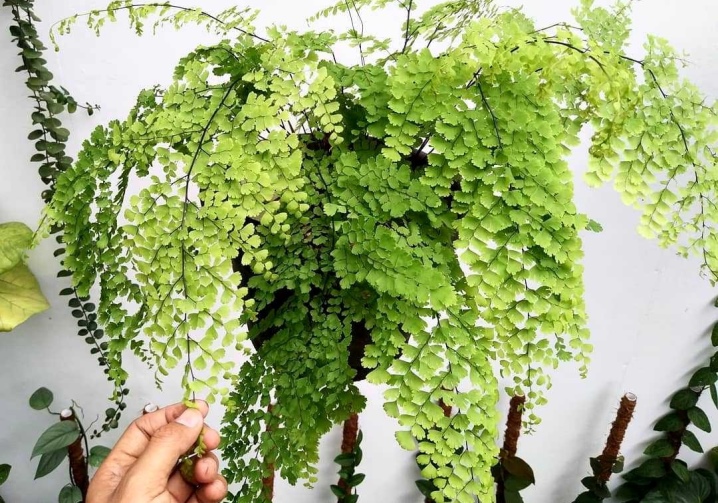
Description
The adiantum (adiant) is a perennial fern-like plant of the Pteris family, includes about 200 species. Most ferns are native to South America and East Asia. In the tropical and subtropical climate of these hemispheres, plants feel great and develop independently. In the nature of our country, there are two types of maidenhair - Adiantum capillus veneris (hair venus) and Adiantum pedatum (foot maidenhair). The common features of all types of maidenhair are:
- thin creeping roots;
- short stature (does not exceed 60 cm);
- dissected drooping leaves (frond), located on dark shiny petioles;
- spores found on the underside of the leaf plates.

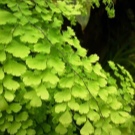




An interesting feature of the maidenhair leaves is that they do not absorb water, but repel it. When water hits the leaves, the drops immediately flow down without wetting their surface. The main difference between the various types is in the size, shape of the dissection of the sheet plates and their color. Depending on the variety, they can be from 5 to 50 cm in length, and the color range varies from light green to red-brown. For the beauty and grace of the leaves, the flower has become very popular with breeders, new decorative forms have been obtained.
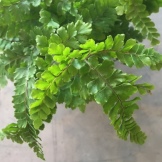



Some varieties add to the ranks of indoor plants, others decorate garden plots.
Types and varieties
Maidenhair delights with their splendor and charm. In regions with a temperate climate, where there are no sharp fluctuations in temperature in winter, they can take root well in the open field.
Varieties for the garden
- Adiantum "Venustum" (Adiantum venustum). It is better known as the beautiful maidenhair. Its drooping, pointed green leaves captivate with their charm. With the onset of cold weather, the color of the leaves turns brown. Often used to decorate gazebos, house walls and shady gardens.

- Foot maidenhair (Adiantum Pedatum Imbricatum). Possesses high frost resistance, can withstand temperatures down to -35 ° С. It is found wild in the mixed forests of the Far East. Due to its unpretentiousness, it adapts well to outdoor and home conditions. It is widely used in landscape design, gets along well and harmonizes with many herbaceous and flowering plant species. It grows up to 60 cm. The leaves are long with feathery dissections, have a light green color and resemble a fan.

Prefers partial shade and humid air.
- Fragrance maidenhair. (Adiantum Fragrans). It grows well, forming neat lush bushes. Winter-hardy, resistant to cold up to - 25 °. Reaches a height of 40-50 cm. Leaves are oval, small in size - 3 cm long and 1.5 cm wide, have a delicate green tint.

- Adiantum Raddianum. Creeping variety with delicate small leaves of light green color. Fern growth is 25-55 cm.The species grows well, forming luxurious thickets. Used for garden decoration and floristry. Delicate twigs look great when decorating flower bouquets and do not fade for a long time. The varieties Liza and Elegance do well in pots, are often used in landscape compositions, and are also suitable for indoor cultivation.

Room maidenhair
- Adiantum capillus-veneris (Adiantum capillus-veneris). Received the name for the similarity of dark flowing stems surrounded by openwork foliage, with long female curls. There is also a legend associated with the name of the flower: the goddess of love Venus threw her lock of hair to the ground, and a beautiful plant appeared in this place. In the nature of our country, hair venus can be found in the mountains of the North Caucasus and Crimea. In gardening, it has not received distribution, but it is the most popular type of indoor ferns. Small saturated green wedge-shaped leaves 2-3 cm long are located on long hanging petioles.

- Large-leaved adiantum (Adiantum macrophyllum). The length of large cirrus leaves is about 30 cm. They are located on black shiny petioles and have triangular dissections. In the first years after planting, red-brown spots are present in the center of the leaf plates, but as they grow older, they disappear, and the leaves become a uniform green color.

- Tenerum adiantum (Adiantum tenerum Swartz). It got its name thanks to the delicate wedge-shaped leaves attached to thin black petioles. Because of this feature, it is prone to frequent leaf fall. It has several varieties, very attractive "Farleyens", whose leaves tend to curl, and "Scutum Roseum" with pink shoots.

- Maidenhair Hispidilum. (Adiantum hispidulum). Better known under the names - finely pubescent and fine-haired, since there are coatings on the petioles and leaves that resemble soft villi. The leaf segments are small, 1–2 cm long, and are diamond-shaped. The petioles are brown, 30-35 cm long. The species has many different forms, the most common are Australian varieties with increased decorativeness, in which young shoots of a pink hue, surrounded by dark green foliage, look great.

- Kidney maidenhair (Adiantum reniforme). An unusual variety with whole, leathery leaves that make it look nothing like typical ferns. The leaf plates are rounded, located on straight, short, dark petioles. The height is 9-15 cm. It is attractive during the ripening of the spores, when brown dots (spores) appear on the edges of the leaves.

- Transparent maidenhair (Adiantum diaphanum Blume). Wide oval feathery leaves have a light green tint and are located on thin petioles of medium length. Spores are formed at the upper edge of the leaves. Fern growth is 35-40 cm.

- Tailed maidenhair (Adiantum Caudatum). On long red-brown petioles, light green leaves are located, each of which has a scion at the end. At home, it looks beautiful in hanging pots, but in comparison with other varieties, it is more demanding in care.

Landing rules
Maidenhair is most often planted as a houseplant. Consider the rules for planting at home. It is better to buy copies in a flower shop in the spring and summer, so that you can immediately transplant into a pot. In stores, maidenhair is usually sold in containers with standard flower soil, but these plants need an improved soil composition. It is worth taking care of the preparation of the substrate in advance. It is necessary to prepare a mixture consisting of equal parts: fertile soil, humus and 1/3 of sand. In the absence of humus, it can be replaced with peat.

You can purchase a special soil for ferns, but according to the observations of flower growers in self-prepared fresh soil, maidenhair trees take root better.
A few hours before planting, the seedling must be watered to make it easier to remove from the old container. For planting, it is advisable to choose a clay pot with drainage holes, since it is better for air permeability and removes excess moisture. Drainage should be placed at the bottom of the pot and the prepared soil mixture should be poured. The seedling is carefully placed in a new pot, the roots are covered with earth and tamped. The plant does not need to be watered for 5-6 days.

Landing in open ground
Despite the fact that some varieties of maidenhair grow well in natural conditions, only adult specimens are recommended to be planted in open ground in temperate climates. It is better to plant in the spring, when planting in autumn, the plant may not have time to adapt to a drop in temperature, which will lead to its death. For planting the maidenhair, you should choose shady places or partial shade, since direct sunlight is undesirable for the flower, they lead to yellowing and rapid leaf fall.

Plants feel good and take root near water bodies.
The selected place is carefully dug up, weeds are removed and a planting hole is dug. Its depth and width should correspond to the size of the roots. When planting several seedlings, the distance between the planting pits should be at least 50 cm so that the root system takes root and grows well. Garden varieties do not need humus; it is better to put a tablespoon of nitroammophoska or urea at the bottom of the pit. The seedling is watered abundantly in advance, removed from the container and lowered into the pit.


It is better to sprinkle it on top with a layer of earth brought from the forest, tamp it and water it moderately.
Care features
Caring for a flower at home is not difficult at all. He prefers partial shade and humid air, so the pots should be placed on the windowsills of the northern and eastern parts of the apartment or in the back of the rooms. An excellent option is to place it near an aquarium, a decorative fountain, an air humidifier or other source of moisture.

Maidenhair is thermophilic, so it should be protected from drafts.
Watering
The flower needs good watering, but you should always make sure that the soil in the pot (or around the root when planting in the garden) is always slightly damp, but without stagnant water. Excess moisture can lead to root rot and death. To ensure the required moisture level, it is recommended to place the flower pot in a bowl of water for 5-7 minutes, and then let the excess water drain off. In the spring-summer period, indoor varieties of maidenhair are watered 3 times a week, in autumn and winter - 1-2 times a week. Garden maidenhair in hot and dry summers can be watered daily, at moderate temperatures (no higher than + 23 ° C), it is enough to water once every 3 days.

Top dressing
Maidenhair require additional feeding only during the growing season. Fertilization is allowed from early May to mid-October and no more than 2 times a month. Preference should be given to organic fertilizers, without lime content.

Winter maintenance
- Indoor varieties. Winter is not a very easy period in the life of indoor maidenhair. When airing the room, it is advisable to remove them from the windowsills, since drafts are poorly reflected on the leaves of the plant, they begin to curl from the cold. Intense heating also affects the health of flowers not in the best way; in dry air, the leaves lack moisture, and they begin to turn yellow and crumble.

In winter, you need to include mandatory spraying with warm water in the care.
- Garden maidenhair. Adiantums wintering in the open field do not need special preparation for the winter period. The roots can be sprinkled with a layer of mulch, it will serve as a natural protection from cold weather and pests. There is no need to create additional shelter, since the plants have good frost resistance.
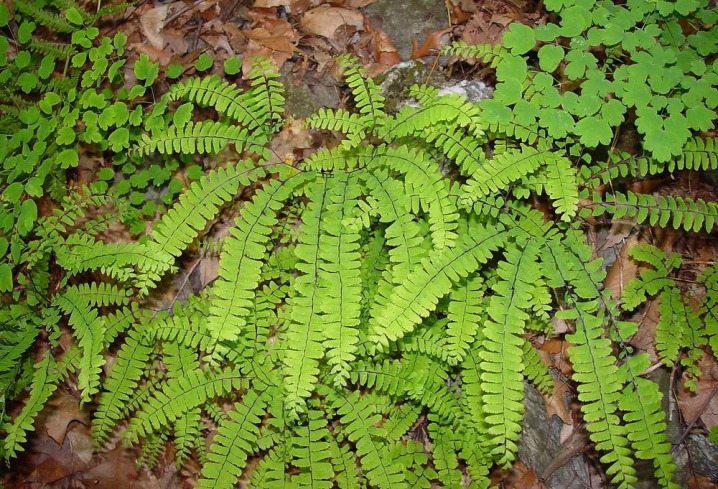
Transfer
The overgrown flower should be replanted after 2-3 years. The optimal time is March-April, until the phase of active growth begins. The pot for the transplant must be selected a little larger than the previous one. Fern on the eve of the procedure should be watered abundantly. Freeing the roots from an earthen coma, they are subjected to a thorough examination. Damaged and rotten areas must be cut off. Drainage is placed at the bottom, and on top is the same soil mixture composition as in the initial planting.

When transplanting, do not overdo it with compacting the soil, it is important to provide air access to the root system. After a week, you can carry out surface loosening.
Reproduction
- Disputes. The spores formed on the inner side of the leaf plates are suitable for reproduction. Spores usually mature at the end of August and retain their properties for several years. They need to be carefully collected and spread on a sheet of paper. When they dry up, they are put away for storage. Easier to store in paper envelopes. In the spring, you can prepare for their sowing. For this, a shallow container is selected, which is filled with a substrate of peat, sand and fertile soil. The soil for disinfection must be doused with boiling water. Once the ground has cooled, seeds are planted superficially and the container is covered with glass or plastic wrap. The germination period of seeds in a warm room is on average 6-8 weeks. When small sprouts appear, the glass (film) is removed, and the container is placed in a bright place not accessible to direct sunlight. Grown up seedlings dive into separate cups.

- Division of the bush. Can be carried out once every 3 years. The fern is carefully removed from the pot and carefully divided into pieces of the same size and transplanted into new containers.


Diseases and pests
Subject to all the rules for keeping maidens, they feel good and delight the owners with their beautiful foliage. But if the conditions of detention are violated, the plant can take on a painful appearance, which in indoor adiantums manifests itself in the following symptoms.
- Paleness of leaves. The reasons lie most often in the fact that direct sunlight falls on the leaves or the roots have grown strongly, which makes the flower cramped. Relocation and transferring to a larger container will help fix the problem.

- Yellowness and leaf fall. Initially, it manifests itself in a change in the color of the leaves, then the plant begins to dry and sheds the foliage. It can occur due to over-watering, when there is a constant stagnation of moisture in the pot, or due to dry air. It is necessary to regulate the irrigation regime and the humidity of the air, it is advisable to add more frequent spraying of the fern.

- Rolling leaves. It is associated with freezing of the plant, especially with frequent ventilation. It is necessary to rearrange the flower in a place inaccessible to drafts, and reduce the frequency of watering.

Diseases of garden fern species are more related to insect pests. The following can pose a threat.
- Thrips. These microscopic insects (no more than 2 mm) are dark or yellowish in color. They lay their eggs on the leaves of ferns, which, having passed into the larval stage, feed on its sap, and then sink into the soil. They get out when the wings appear and flutter from one plant to another, continuing to feed on the juice and infecting it with their virus. The disease manifests itself in the formation of red-brown spots along the edges of the leaf, which soon completely cover the leaves. It is quite difficult to save and save the maidenhair with such a disease. It is necessary to remove the affected leaves and treat with a weak solution of denatured alcohol. These procedures should be done as soon as possible, when the first spots are found.

With a large number of infected leaves, the plant will have to be disposed of so that the virus does not spread to other crops.
- Shield. Small greenish-yellow insects attach to any part of the leaf, sucking the juice out of them.At the initial stages of parasites, you may not immediately notice, but when stickiness appears on fronds, it is worth carefully considering the plant. Scabbards secrete a sticky secret, which subsequently leads to the formation of yellow or light brown spots. The growth of the maidenhair gradually slows down, the leaves quickly turn yellow and fall off. If scabbards are found, they must be immediately removed from the plant using a cotton pad or soft brush dipped in soapy water. After cleaning, an insecticide treatment is performed. Effective drugs "Aktara", "Bankol", "Mospilan".
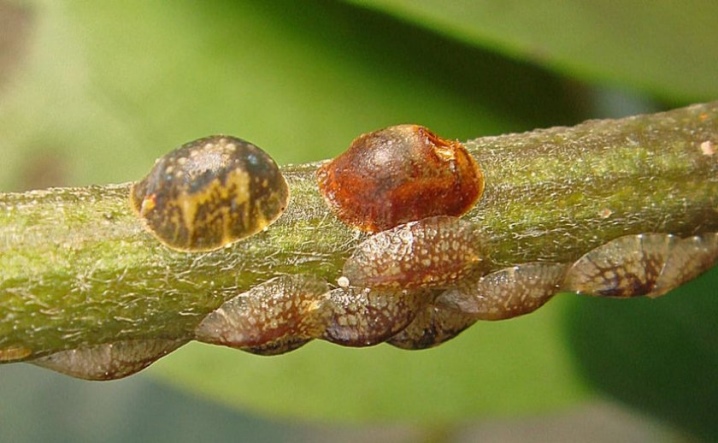
- Spider mite. Insects attach themselves to the inside of the leaves, feeding on sap, which causes them to dry out, curl and fall off. Spraying the bush with soapy water or karbofos solution will help get rid of pests.
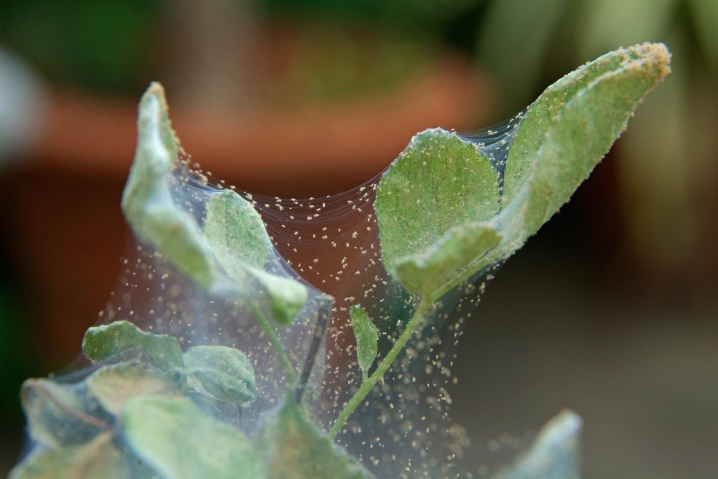
- Aphid. It is quite common. Small green insects stick tightly to the underside of the leaves, which interferes with the development of the maidenhair. It becomes lethargic and loses its decorative effect. To combat aphids, you can make infusions of garlic or wormwood and spray the fern.

In some cases, indoor maidens can also be susceptible to these pests, in order to reduce the risk of damage, preventive measures must be taken:
- inspect ferns weekly;
- Treat the soil with a weak solution of manganese once a year;
- transplant only into fresh soil;
- do not place plants near an open window and near the front door;
- inspect the copies carefully before purchasing.


The attitude to the flower will allow you to notice the first signs of disease or pest damage in a timely manner, which will allow them to be eliminated at the initial stages, even without the use of chemicals. From all the variety of species and varieties, you can pick up magnificent specimens of maidenhair, in accordance with personal tastes and preferences.
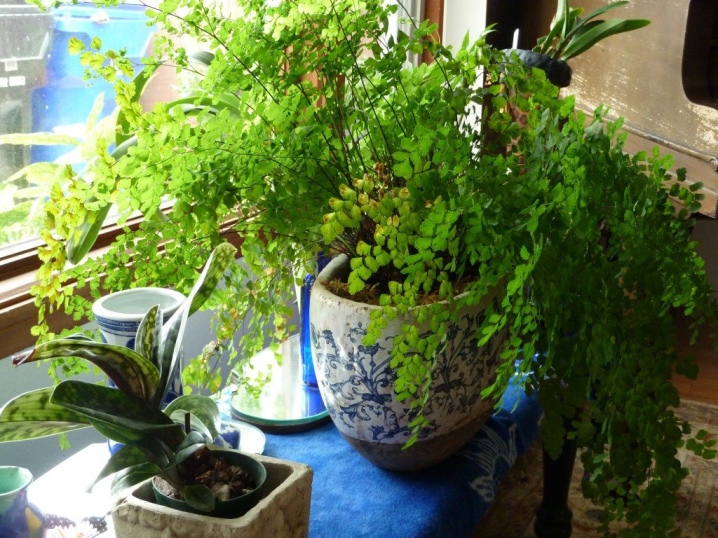
Subject to all conditions of detention, they will be an excellent decoration for your home or garden.
For information on how to properly care for the maidenhair, see the next video.































The comment was sent successfully.